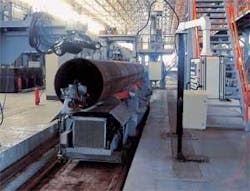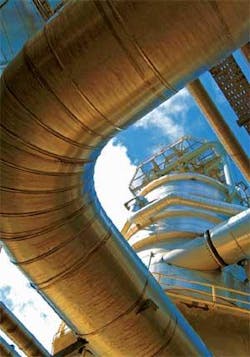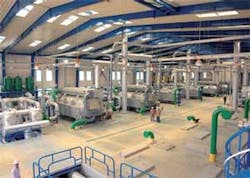Natural gas discoveries like those in the Obaiyed and Khalda concessions will be important to the growth of Egypt’s energy sector and the country’s economy. There will be plenty of demand for Egypt’s growing gas supply, and many opportunities for investment, said Eng. Salah Diab, Chairman, PICO Corp.
“We have enough proven gas resources to support growth for the next 30 years or so. Based on forecasts, there will be no need to begin importing gas,” he said.
Mr. Diab also would like to see Egypt becoming a regional hub for gas processing and liquefaction. “We have a large population to supply, but if there is gas to spare, it makes sense to encourage people to come to Egypt and invest.”
Though Egypt’s political stability has historically drawn foreign investors, increasing tensions in the region threaten to erode the confidence of those considering investment in the wider Middle East.
“But Egypt has long been very stable and we see no evidence that this will change,” said Mr. Diab.
Pico strategy
In 1978, PICO Petroleum Services (PPS) became the first private Egyptian enterprise to offer oilfield services for the local oil and gas market. In 1991, PICO Oil was established as the first Egyptian company to own and operate oil fields. A decade later, PICO launched its newest unit, PICO Research and Analysis (R&A). PICO Energy was established in 2002 as a holding company for the existing subsidiaries and to explore the promise of alternative energy sources.
Because Pico is well funded, it is actively seeking investment opportunities in North Africa, the Caspian and other areas in the Middle East.
“We would like to be a regional player and I think we have all the qualifications needed to become one,” said Mr. Diab. “We have the equipment, technology and staff to achieve that goal.”
Pico also plans to put forward an initial private offering (IPO) as soon as possible.
With an increasingly intense focus on offshore and deep water development, the company’s history of increasing production levels in the fields it operates will serve the company well.
PICO began life by “picking up the leftovers” of major international operators as they moved on to frontier areas, said Mr. Diab. “Those leftovers kept us busy trying to produce whatever we could, and I think we have had significant success.”
Rather than take properties from EGPC, PICO acquired concessions that did not fit in the portfolios of international operators.
“Since those concessions were all we had, we spared no effort to maximize their potential and I think we have succeeded. What was left behind as having little potential is now producing more than 25,000 b/d.”
And in 2004, a technical review confirmed that substantial value remained in all of Pico’s fields.
That success is due in a large part to PICO’s ability to apply fit-for-purpose solutions to the development of its assets. Low operating cost is another advantage. “We don’t do any unnecessary spending,” said Mr. Diab. “For example, we might use an old drilling rig as a water injection platform.”
Now, the company is moving to take advantage of potential exploration opportunities in Egypt and elsewhere. “We expect to move into Iraq and Sudan as soon as conditions warrant, and to Algeria,” he said.
As the first Egyptian petroleum services contractor, PICO quickly became a capable oil and gas service provider in Egypt. The company’s joint-venture agreements, however, did not permit it to operate outside Egypt.
“Now we are releasing ourselves from this restriction, and I think we have accumulated the know-how to take our services to other countries,” said Mr. Diab.
He also sees other companies with extensive technical expertise moving beyond being subcontractors to become operators. There is “a very thin line between the integrated services provided by the large international service companies and the way the large operators develop an oil or gas field,” he said. “That thin line is bound to disappear eventually.”
Though the concern still exists that entry by service companies into operating ownership of fields will cause them to lose business from traditional operators, Mr. Diab thinks that is about to change.
To achieve the goals of its strategy, PICO is intent on developing its intellectual capital. “We are attracting young, energetic people whom we train, empower, then allow to share in the benefits of any success,” said Mr. Diab. PICO has also invested heavily to attract Egypt’s most skilled and well-established technicians to help optimize ultimate recovery and maximize production.
“My biggest responsibility is to ensure that there is the qualified staff to continue our strategy well into the future,” said Mr. Diab.
Pipelines expand grid
Enhancing the capacity of Egypt’s gas grid and upgrading its infrastructure will accommodate growing demand for natural gas and help serve new domestic and export markets.
Progress in the execution of many Gasco projects accelerated in 2006 as several pipeline projects moved ahead.
The El-Tina/Abu Sultan pipeline, a 62-km (37-mile), 32-in. line capable of moving 16 MMcfd of gas was built to support the eastern flank of the national gas grid. Started up in early 2007, it uses gas supplied by Port Fouad and northern Port Said fields to meet the demand of the domestic market in Suez and the northern Gulf of Suez. Total cost of the project was about L.E 236 million.
Dahshour-Kuraimat pipeline, 90 km (56 miles) of 36 in., has a capacity of 37 MMcfd. It serves the expansion of the Kuraimat power station and growing demand in the southern expansion of the national grid. Costing about L.E 385 million, it began operation in early 2007.
In 2006, Gasco began building a gas pipeline to feed gas to South Sinai. The Taba/Sharm El-Sheikh pipeline, 220 km (137 miles) of 20 in., will carry up to 6 MMcfd to serve the cities on the route, hotels and tourist villages, in addition to power stations in Taba, Noweba, Dahab and Sharm El-Sheikh. It went on line in early 2007 at a cost of about L.E. 511 million.
Also during 2006, Gasco completed the Shukeir-Hurgada pipeline, 127 km (79 miles) of 24 in. that can handle 7 MMcfd of gas for the Red Sea Governorate. The pipeline will serve the cities and power stations on the route. Estimated cost of the line was L.E. 336 million.
South Valley
Within the framework of the Ministry of Petroleum’s plan to develop the south of the valley, and Gasco’s plan to supply the South Valley governorates, Gasco began the first section of the South Valley pipeline in early 2006. The Beni-Suef/Abu Qorqas line is 150 km (93 miles) of 32 in. with a capacity of 16 MMcfd. It was completed in mid 2007 at a cost of about L.E 545 million.
The second phase, from Menya to Assiut, is 136 km (85 miles) of 32 in. Estimated to cost about L.E 520 million, it is scheduled for startup in second quarter 2008.
By the third quarter of 2007, after completing the pipelines supplying gas to the cities of Sharm El-Sheikh, Hurgada and Beni-Suef, total length of the south valley grid reached about 800 km. Grid transmission capacity was 166 MMcfd.
El-Qasr tie in
Gas production from El-Qasr field in the Khalda concession began in 1998 and by the end of 2006 was averaging almost 500 MMcfd. Oil production began in the concession in the mid 1980s and now averages 80,000 b/d. By the end of 2006, cumulative gas production was 782 bcf. The field has also produced 47 million bbl of condensate and 284 million bbl of oil.
The project involves two phases: El-Qasr Early (capacity up to 150 MMcfd of gas plus associated liquids) and El-Qasr Permanent. Capacity of the first phase, completed in 2005, is expected to increase to 210 MMcfd after the commissioning of a pre-compression project in early 2008.
By tying the El-Qasr field into the Obaiyed gas processing facilities, it was not necessary to build a new gas processing plant in Khalda.




